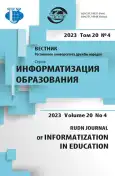Formation of schoolchildren’ divergent thinking in the conditions of additional education when working with timelines
- Autores: Gerasimova E.K.1, Nimatulaev M.M.2, Novoselova S.Y.3, Shishkov M.S.4
-
Afiliações:
- North Caucasus Federal University
- Financial University under the Government of the Russian Federation
- Sochi Institute (Branch) of RUDN University
- School No. 1506
- Edição: Volume 20, Nº 4 (2023)
- Páginas: 373-385
- Seção: EVOLUTION OF TEACHING AND LEARNING THROUGH TECHNOLOGY
- URL: https://journal-vniispk.ru/2312-8631/article/view/321271
- DOI: https://doi.org/10.22363/2312-8631-2023-20-4-373-385
- EDN: https://elibrary.ru/BTMJPY
- ID: 321271
Citar
Texto integral
Resumo
Problem statement . One of the most important tasks that digital school teachers face is preparing a graduate, who is ready to use the acquired knowledge in his future life and find non-standard, original solutions, overcoming the usual patterns and established opinions. The study aimed at substantiating the effectiveness of the use of timeline services for the development of divergent thinking in schoolchildren in the conditions of additional education. Methodology . Theoretical and methodological analysis and generalization of fundamental scientific works on the research problem, processing of test results and timelines were applied. The pedagogical experiment involved 130 students of the state budgetary educational institution of Moscow “School No. 1506”. To diagnose and assess the formation of divergent thinking, the method of F. Williams (adapted by E.E. Tunik) was used. Pearson's chi-square test was used as a statistical processing method. Results . The timeline in additional education was carried out when displaying historical facts in chronological order, compiling algorithms, creating biographies, and presenting statistics. The didactic potential of the timeline as a kind of quantitative infographics is revealed, which offers a graphical implementation of digital data in relation to each component in the structure of creativity: flexibility, originality, elaboration, fluency. Statistically significant differences in qualitative changes in the pedagogical system were determined. Conclusion . The use of timeline services in the conditions of additional education contributes to the development of divergent thinking of students due to the possibilities of interactive presentation of events and facts, reuse, multimedia, technical minimalism. Difficulties that complicate the use of virtual timelines are noted: time resource management, the need to develop criteria and indicators for the effective use of web services for the corresponding purpose.
Sobre autores
Elena Gerasimova
North Caucasus Federal University
Autor responsável pela correspondência
Email: elkongerasimova@gmail.com
ORCID ID: 0000-0003-3758-8533
Candidate of Pedagogical Sciences, Associate Professor of the Department of Informatics, Institute of Digital Development
1 Pushkina St, Stavropol, 355009, Russian FederationMagomedkhan Nimatulaev
Financial University under the Government of the Russian Federation
Email: mnimatulaev@fa.ru
ORCID ID: 0000-0003-4290-6073
Doctor of Pedagogical Sciences, Professor of the Department of Business Informatics
49 Leningradskii Prospekt, Moscow, 125993, Russian FederationSvetlana Novoselova
Sochi Institute (Branch) of RUDN University
Email: novoselovaapk@mail.ru
ORCID ID: 0000-0002-2289-6878
Doctor of Pedagogical Sciences, Associate Professor, Professor of the Department of the Russian Language and Methods of its Teaching
32 Kuibysheva St, Sochi, 354340, Russian FederationMikhail Shishkov
School No. 1506
Email: ladogamc@ya.ru
ORCID ID: 0009-0008-9991-9776
computer science teacher
1A Shirokaya St, Moscow, 127282, Russian FederationBibliografia
- Dilekci A, Karatay H. The effects of the 21st century skills curriculum on the development of students’ creative thinking skills. Thinking Skills and Creativity. 2023;47: 101229. http://doi.org/10.1016/j.tsc.2022.101229
- Avcı Ü, Yildiz-Durak H. Innovative thinking skills and creative thinking dispositions in learning environments: antecedents and consequences. Thinking Skills and Creativity. 2023;47:101225. http://doi.org/10.1016/j.tsc.2022.101225
- Khaknazarov SKh. Parents’ satisfaction with the quality of additional education of children in their native languages and literature. Bulletin of Ugric Studies. 2022;12(2):386-397. (In Russ.) http://doi.org/10.30624/2220-4156-2022-12-2-386-397
- Stepanov SYu, Ryabova IV, Gavrilova EV. The impact of the digital environment and additional education on the intellectual and creative abilities of schoolchildren. Questions of Psychology. 2021;(1):61-70. (In Russ.)
- Malova EN, Shubovich VG, Shubovich MM. Information and communication technologies in supplementary education of primary students: health aspect. Theory and Practice of Physical Culture. 2019;12:70-72. (In Russ.)
- Ageev NYa, Tokarchuk YA, Tokarchuk AM, Gavrilova EV. The interaction of digital technologies with the development of cognitive and communication processes of adolescents and young adults: a review of empirical research. Psychological-Educational Studies. 2023;15(1):37-55. (In Russ.) http://doi.org/10.17759/psyedu.2023150103
- Uranova VV, Bliznyak OV, Mazhitova MV, Isyakaeva RR. Role of visualization of educational information in the educational process of medical and biological students in the “Analytical chemistry” discipline. Russian Journal of Education and Psychology. 2022;13(6):19-44. (In Russ.) http://doi.org/10.12731/2658-4034-2022-13-6-19-44
- Guilford J. Structural model of intelligence. In Matyushkin AM. (ed.) Psychology of Thinking. Moscow: Gardariki Publ.; 2005. p. 37-45. (In Russ.)
- Delany DE, Cheung CS. Transactions between adolescents' after school activities and divergent thinking. Psychology of Aesthetics, Creativity, and the Arts. 2020;14(4):462-474. http://doi.org/10.1037/aca0000266
- Ibraeva ES. Development of interest in STEM education among primary school children in the system of supplementary education. Perspectives of Science and Education. 2023;(1):276-290. (In Russ.) http://doi.org/10.32744/pse.2023.1.16
- Bykova SS, Buyanova IB, Serikova LA. The development of divergent thinking in younger adolescents by the means of TRIZ-Pedagogy. Perspectives of Science and Education. 2020;45(3):323-335. (In Russ.) http://doi.org/10.32744/pse.2020.3.24
- Colzato LS, Ritter SM, Steenbergen L. Transcutaneous vagus nerve stimulation (tVNS) enhances divergent thinking. Neuropsychologia. 2018;111:72-76. http://doi.org/10.1016/j.neuropsychologia.2018.01.003
- Durnali M, Orakci S, Khalil T. Fostering creative thinking skills to burst the effect of emotional intelligence on entrepreneurial skills. Thinking Skills and Creativity. 2022;47:101200. http://doi.org/10.1016/j.tsc.2022.101200
- Karvunis YA, Lozhkina MB, Kapilevich LV. E-training (distance learning) elements for supplementary sports tourism education service: benefits analysis. Theory and Practice of Physical Culture. 2021;10:64-65. (In Russ.)
- Soboleva EV, Suvorova TN, Blokhina NYu, Batakova EL. Formation of group creative thinking when working with virtual walls. Perspectives of Science and Education. 2021;(3):465-480. (In Russ.) http://doi.org/10.32744/pse.2021.3.33
- Kechaeva MV, Salynina SU. The role of the system of additional education of children in the process of socialization of the individual. Modern Problems of Science and Education. 2023;(1). (In Russ.) http://doi.org/10.17513/spno.32367
Arquivos suplementares









